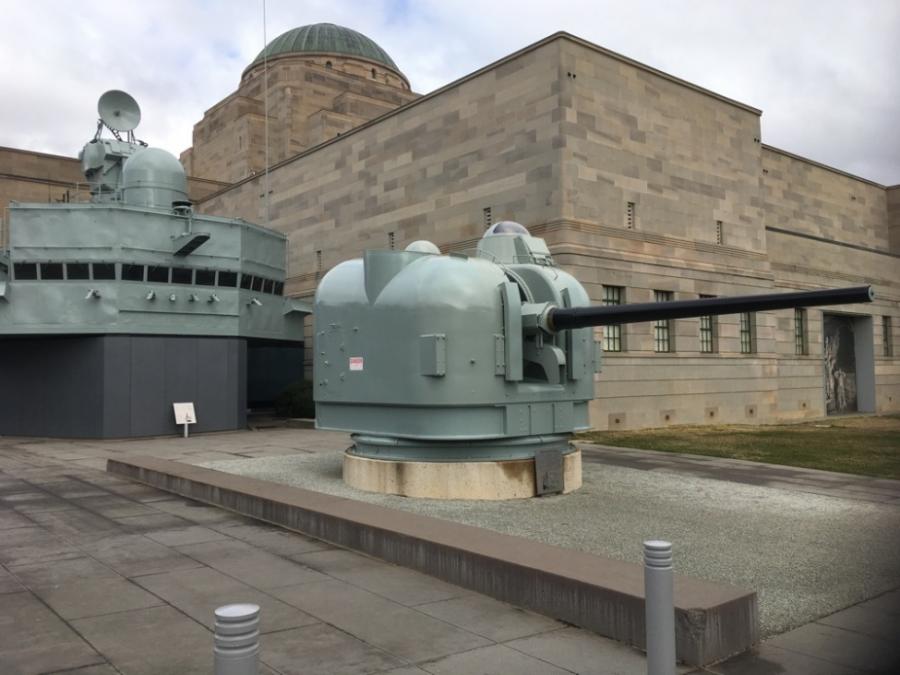HMAS Brisbane
HMAS Brisbane [II] (1966) was the second vessel of that name to serve in the Royal Australian Navy. She was the third of the RAN's American-built "Charles F. Adams" class guided-missiles destroyers. (The other two were HMAS Hobart and HMAS Perth.) These ships cost $40 million each (or $50 million with missiles) and were the first major Australian warships designed and built in America. They carried a complement of 20 officers and 312 sailors. Apart from the 5-inch/54 calibre guns, they were armed with Ikara missile systems and anti-submarine torpedoes.
Service
Brisbane undertook two tours of duty with the United States Seventh Fleet off Vietnam, in 1969 and again in 1971, and was the last ship of the RAN to serve there. On each occasion, she fired approximately 8,000 rounds of ammunition while on the gunline. As successive destroyers went on the gunline, they were passed "the weight". "The weight", comprising the bases of two 5-inch powder cases, symbolised the responsibility imposed on RAN destroyers that served with the Seventh Fleet. It is inscribed on the lower section with the names, dates, and call signs of the destroyers that served with the fleet. While on a firing mission on 22 July 1969, her forward 5-inch gun (Mount 51) suffered an inbore explosion. One sailor was slightly injured. Brisbane spent the next 15 days with only one operational gun before retiring to Subic Bay in the Philippines for repairs.
During the Gulf War (1990-91), Brisbane was one of four Australian warships to serve a tour in Gulf waters. These formed part of the anti-aircraft screen for the US Navy carrier battle groups. Brisbane arrived in the Gulf in December 1990 and served there until March 1991, performing a number of roles. Apart from contributing to the anti-air defences in the carrier screen, she also kept watch for mines and ensured that small civilian craft kept well away from the carrier group. Later, during Desert Storm, Brisbane controlled fighter combat air patrols and tanker aircraft. Her final role was as an escort for US replenishment ships.
Mount 52
This gun mount was the aft mount (Mount 52) on the ship. The ammunition feed system for the single 5-inch gun was almost entirely automated and this meant that it could achieve a continuous firing rate equal to what an expert crew could manage over short bursts using two gun mounts. The starboard "bubble" dome, or "frog-eye", has been removed. This dome was normally used for anti-aircraft fire control within the mount (the retained port dome being used for local surface control), but this was not needed here because of the use of the Tartar anti-aircraft missile system on these Australian ships.

This is the original mount, although the gun would have been re-barrelled a number of times. Normal barrel life was approximately 1500 rounds.
Photo courtesy: Navy
Gun Mount 52
| Calibre: | 127 mm (5-inch) |
| Barrel length: | 54 calibres |
| Rate of fire: | 45 rounds/min |
| Maximum range: | Approx. 24 km |
| Weight of projectile: | Approx. 32 kg |
| Weight of mount: | 60 tons (complete) |
| Barrel life: | Approx. 1500 rounds |
HMAS Brisbane
| Type: | "Charles F. Adams" class guided-missile destroyer (DDG) |
| Launched: | 5 May 1966 |
| Built by: | Defoe Shipbuilding Co, Bay City, Michigan, USA |
| Displacement: | 3,370 tons (standard); 4,500 tons (full load) |
| Length: | 133.19 m |
| Speed: | 35 knots |


